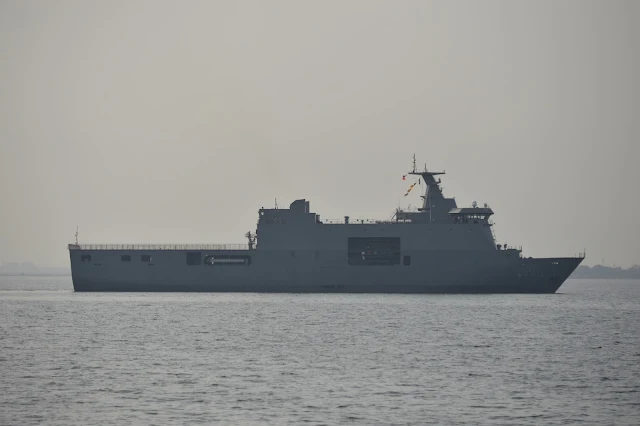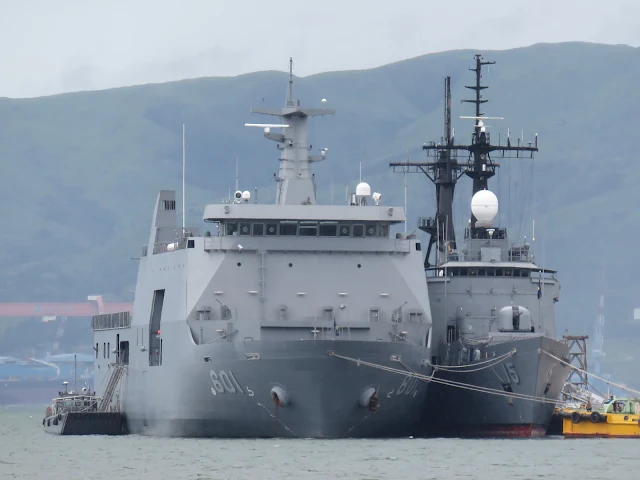This acquisition project serves as the third one awarded to the South Korean shipbuilder Hyundai Heavy Industries, after the Frigate Acquisition Project of the First Horizon which is now called the Jose Rizal-class Frigates, and the Corvette Acquisition Project, in which its design cues have derived from the Jose Rizal-class Frigates, with its design name being the HDC-3100.
While the offer made by the South Korean shipbuilder is something we've discussed here in Pitz Defense Analysis, there are some variations made to the offer provided to the Philippine Navy that deserve its own discussion, which is the main purpose of this article.
THE DETAILS PROVIDED IN THE NEWS
Before the change in administration took place on June 30, 2022, the Department of National Defense sealed a deal with the South Korean shipbuilder Hyundai Heavy Industries for the construction of six (6) Offshore Patrol Vessels for the Philippine Navy when both parties signed the contract that may stipulate the obligations of both the buyer and the seller involved, from delivery dates to the milestone payment schemes.
The allotted budget for the contract or ABC has amounted to Php 30 Billion, which is equivalent to Php 5 Billion per Offshore Patrol Vessel constructed by the South Korean shipbuilder, with the design of the vessels may get derived from the HDP-1500 Offshore Patrol Vessel design of Hyundai Heavy Industries, although there are noticeable changes in the design such as having a stretched hull of around 94.4 meters (see image above).
The stretched hull counts as an improvement over the 81-metered design of the original HDP-1500 Offshore Patrol Vessel offer by Hyundai Heavy Industries, and even better than Austal's 81.7 metered offshore patrol vessel offer, whereby the 94.4 metered vessel may provide additional space for future upgrades at the discretion of the Philippine Navy, with the option of making it formidable by adding weapons subcomponents onboard.
Former Secretary of National Defense Delfin Lorenzana said in this report that his office during that time did not allow the Offshore Patrol Vessel Acquisition Project to get dragged on until the next administration, as the Philippine Peso being at the disadvantage against the U.S. Dollar in the exchange rate, whereby it is at US$1.00 - Php 55.00 at the time this article has written, while the Offshore Patrol Vessel deal pegged at US$1.00 - Php 52.00 exchange rate.
Aside from an improvement in the hull design of the Offshore Patrol Vessels, the contract also provides a license for the Philippine Navy to manufacture or build using the design provided for this acquisition project exclusive for the Philippine government to use, which is basically a transfer of technology that may help push the shipbuilding portion of the Self-Reliance Defense Posture or SRDP.
The license or what we call as transfer of technology may help catalyst the push for Self-Reliance Defense Posture, which itself may go as the primary highlight for the Third Horizon of the Revised Armed Forces of the Philippines Modernization Program, whereby in-production of military hardware, innovation, and multiple transfers of technology are the highlight under this initiative.
Given that there are revisions in the design of the Philippine Navy Offshore Patrol Vessels, along with the clarity of information that has provided in the specifications of what Hyundai Heavy may soon provide for the Offshore Combat Force and the Philippine fleet in its entirety, we will discuss in-depth about the revisions in the design specifications, and also the features plus subcomponents that may find in these warships.
SPECIFICATIONS
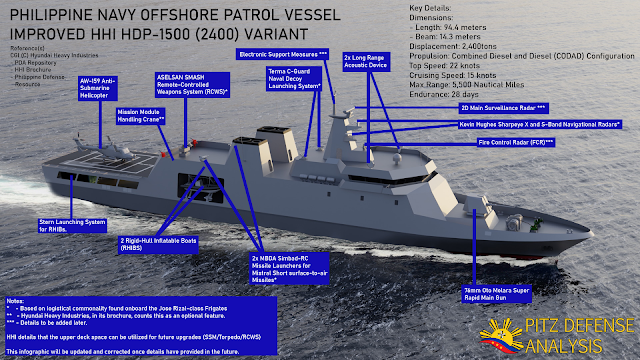 |
| Similar to the first image, a CGI from Hyundai Heavy Industries, now filled with additional information about the OPV's subcomponents, specifications, and dimensions, with data got from other defense outlets. |
Pitz Defense Analysis Note: The infographic content provided is not totally complete at the time this article published, as there may be changes taking place in the design or in the subcomponents of the new Offshore Patrol Vessels of the Philippine Navy, whereby the references include the subsystems found onboard the Jose Rizal-class Frigates, as this makes sense from the logistical and commonality point of view.
Given the infographic above, we can see that there is a significant improvement in the overall design of the Offshore Patrol Vessel design as offered by Hyundai Heavy Industries to the Philippine Navy, as its size are larger than several of the existing warships in the fleet such as the BRP Conrado Yap (PS-39), a Pohang-class Corvette from South Korea, formerly known as the ROKS Chungju (PCC-762).
Having a 94-meter length and 14.3-meter beam dimension, the Offshore Patrol Vessels have sufficient spaces for future upgrades such as a weapons fit for anti-ship missiles and torpedo launchers, making it formidable enough and may get re-categorized as light corvettes, although these things will come at the discretion of the Philippine Navy as an end-user, whether these add-ins are necessary to the ship's capability.
Known subcomponents such as the 76mm Oto Melara Super Rapid Main Gun, MBDA Simbad-RC Missile Launchers for Mistral short surface-to-air missiles, and ASELSAN SMASH 30mm Remote-Controlled Weapons System (RCWS) are also available onboard the Jose Rizal-class Frigates, whereby it made sense from logistical and commonality point of view, giving Philippine Navy personnel an advantage of streamlined maintenance for common spare parts, and on operational use that it does not require taking a learning curve in utilizing these weapons systems.
Also, the ships came with 2 units of long-range acoustic device or LRAD per vessel, whereby it can use as a sound-based weapon that can disable insurgents at sea like pirates from doing threatening things that put harm on the sea lanes, or as a warning for other vessels that approach a naval vessel to change course using its high-decibel sound it emits while avoiding the use of lethal force against any threatening vessel.
With 2,400tons, these Offshore Patrol Vessels may not count as the HDP-1500 design, which only has 1,500tons as originally offered by Hyundai Heavy Industries to the Philippine Navy, but these warships instead may now consider as the HDP-2400 Offshore Patrol Vessel design, as the enlarged hull and increased tonnage makes it distinct and different from the HDP-1500 design albeit that the HDP-2400 has clearly derived itself from the HDP-1500 design.
Now that we have an infographic overview of the subsystems found on-board the HDP-2400 Offshore Patrol Vessels of the Philippine Navy, we will discuss several of these systems in-depth, including the ones that are available onboard the Jose Rizal-class Frigates that are not yet being tackled here in Pitz Defense Analysis website as additional information will provide an insight to the capabilities of these naval vessels.
ASELSAN SMASH 30MM SECONDARY GUN SYSTEM
 |
This is one product that the Turkish weapons company produces, aside from the GOKDENIZ 35mm CIWS.
(c) ASELSAN, via Image Source. |
These 30mm Secondary Gun Systems are from a Turkish-based defense company ASELSAN, the same company that produces the 35mm GOKDENIZ Close-In Weapons System or CIWS that the Philippine Navy HDC-3100 Corvettes may now soon be having in the wide array of weapons subcomponents fitted in a ship, and also the one that has similar remotely controlled weapons system or RCWS fitted onboard the Jose Rizal Frigates.
Like any Mk.44 Bushmaster II weapon mounts, ASELSAN SMASH Remote-Controlled Weapons System benefits to the dual feed system that made the impressive 200 rounds per minute firing possible, while having a stabilized system that enables the controller to fire at a target that poses a threat on the ship without the worry on accuracy that is typically affected by waves of different sea states.
As ASELSAN advertise it in their brochure and we quote, "SMASH is a Remote Controlled Naval Gun System fitted with a 30 mm gun integrated on a stabilized pedestal with independent Electro-Optic Sight and surveillance mode (without aiming the gun)", they depicted that this gun system has a sophisticated feature that can monitor the warship's surroundings in its line of sight even without using the gun turret, making it less noticeable for any vessel in its line of sight that they are being monitored.
Regarding its service within the Philippine Navy, the personnel onboard BRP Antonio Luna (FF-151) used its ASELSAN 30mm Remote-Controlled Weapons System in a gunnery exercise, alongside its 76mm Oto Melara Super Rapid Main Gun and a 0.50mm machine gun mounts as it aimed its targets deployed by the Royal Canadian Navy Frigate HCMS Winnipeg (FFH-338) at-sea during RIMPAC 2022 exercise.
The gunnery exercises that the BRP Antonio Luna took part during RIMPAC 2022 exercise off the coast of the Hawaiian islands made it one of the best naval vessels as it landed third in the Naval Surface Fire Support (NSFS) Rodeo, showing the firing accuracy that the crew has while utilizing the ship's weapons system, including the Turkish ASELSAN SMASH 30mm Secondary Gun System.
BRP Antonio Luna (FF-151)'s award in the gunnery exercises and the experiences they have during the at-sea phase of RIMPAC 2022 may help its crew share important skill-sets that may help the people in the Philippine Navy to further hone the use of its key weapons systems onboard their naval vessels sufficiently, whereby accurate operations for the Turkish-developed Remote-Controlled Weapons Systems System are more effective in a skillful hand of a well-trained naval personnel.
MBDA SIMBAD-RC FOR MISTRAL SHORT ANTI-AIR MISSILES
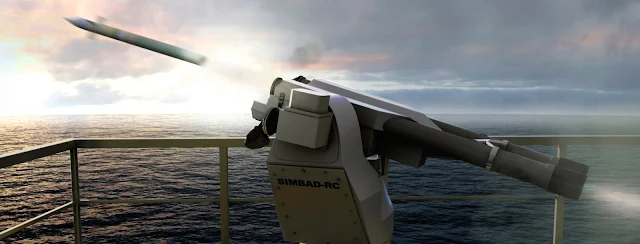 |
| Here's what to be the minimal anti-air defense systems of the Offshore Patrol Vessels. (c) MBDA Systems. |
While the Jose Rizal-class Frigates got these short anti-air missile mounts as an augmentation measure for both its Fitted For But Not With (FFBNW) components, such as the Close-In Weapons System or CIWS and Vertical Launch System or VLS, the Offshore Patrol Vessels that the Philippine Navy may soon have, may render these platforms as a necessity for its own air defense measures.
It is an understandable thing, given that Offshore Patrol Vessels by design are not more combative, as compared to its Frigate and Corvette counterparts that have typically installed with sophisticated subsystems such as the ones just mentioned, designed to have a descent air defense system that aimed to protect a warship against any incoming airborne threats such as a missile or an incoming unmanned aerial system or aircraft.
Unlike the typical Mistral MANPADS or Man-Portable Air Defense Systems that typically came with a single Mistral missiles fit, the SIMBAD-RC missile launcher comes with two Mistral 'fire-and-forget' missiles as what this brochure from MBDA describes it, especially that its sophisticated high-technology tracking system comes as an infrared homing seeker that enables the missiles that are fully automated during flight.
The essentials of a homing seeker make it simple for the operator of the SIMBAD-RC missile launcher to use, as the learning curve is not steep for any assigned naval personnel in taking up a training in operating the VSHORAD or very short air defense system, and as what MBDA brochure describes it once again, that such systems do not require a fire control system similar on what is typically being paired on the 76mm Oto Melara Super Rapid Main Gun.
The SIMBAD-RC missile launcher itself comes fully automatic, as it can get remotely controlled through a terminal, going similar to the ASELSAN SMASH 30mm Remote-Controlled Weapons Systems or RCWS, making all the weapons systems onboard an HDP-2400 Offshore Patrol Vessels automatically operated, minimizing exposure of naval personnel from gunfire.
A simple anti-air defense system as the SIMBAD-RC for Mistral missile system is fairly essential for an Offshore Patrol Vessel that lacks sufficient air defense system as the HDP-2400 design provided by the South Korean shipbuilder to the Philippine Navy, as these simple-to-use systems gives a sufficient cover against minute threats coming from the sky, as these warships has designed to patrol the country's waters.
LONG-RANGE ACOUSTIC DEVICE OR LRAD
While the first two subsystems are a common thing within the Philippine Navy, especially that it is also available onboard the Jose Rizal-class Frigate, this one is an entirely unique system found onboard the HDP-2400 Offshore Patrol Vessels, as this primarily serve as a non-lethal weapon system aimed at warding off other vessels that are within the perimeter of these warships.
Talking about piracy, the Long Range Acoustic System or LRAD has credited for warning of pirates in an area off coast of Somalia, as a cruise ship used this nonlethal weapon system that emits a beam of sound that drove these harmful people away from the ship, averting what could be a highly risky situation that the ship, its crew, and the passengers onboard being hostage by Somali pirates.
An LRAD unit works by emitting a beam of sound, sound that is so loud that it is audible for long distances, fully appropriate for the Philippine Navy Offshore Patrol Vessels in communicating to other vessels that are lacking with radio equipment, or sending a warning on other vessels to veer course if it get close to the warships, aside from the mentioned deterrence against piracy and other maritime crimes using the LRAD's unbearable noise emitter.
With a weapon system like a LRAD, this may help the Philippine Navy HDP-2400 Offshore Patrol Vessels in conducting operations in such porous waters, as this gives them an additional weapon option, with this one not requiring the use any of its live munitions and weapons subsystems found onboard the ship, and instead use the same in more dire situations that may justify the use of such lethal weapons.
Also, this weapon system adds more to the capability of the Offshore Patrol Vessels in the sense that these ships can effectively patrol other areas of the Philippine archipelago that have little worrying threat from external forces, enabling more capable combatants like the Jose Rizal-class Frigates and the HDC-3100 Corvettes that the Philippine Navy also ordered from South Korea get deploy on areas with more concern such as the West Philippine Sea as China's aggression is always of constant threat in that area.
Simply put, it is welcoming that the HDP-2400 Offshore Patrol Vessels that the Philippine Navy may get years from now comes with this feature, as this is helpful in areas aforementioned that its concern hampers the peace and security in the country's Sulu and Celebes Sea areas, while assuring that deterring these threats promote economic development that benefit the country in its entirety.
COMPARISONS
Comparing to the original HDP-1500 Neo design provided by Hyundai Heavy Industries as part of its Offshore Patrol Vessel portfolio, the HDP-2400 has presented as an improvement in terms of tonnage provided, as well as with its hull size, whereby the length increased by 13.4 meters, while the breadth has increased by at least 1.2 meters, making it larger to afford future upgrades.
In comparison, the HDP-2400 Offshore Patrol Vessels are in any way larger than the Jacinto-class Patrol Vessels (JCPVs) of the Philippine Navy, whereby these former Peacock-class Patrol Vessels of the British Royal Navy have a length of around 62 meters and breadth of around 10 meters, whilst having a tonnage of only around 712 tons, showing how far the Philippine fleet has improved now with improved warship designs.
Aside from the Jacinto-class Patrol Vessels or JCPVs, the HDP-2400 Offshore Patrol Vessels are also larger than the BRP Conrado Yap PS-39, a Pohang-class Corvette from South Korea that once served in the Republic of Korea Navy (ROKN) as ROKS Chungju (PCC-772), whereby it has a length of 88.3 meters, breadth of 10 meters, and a ship displacement of 1,200tons.
Let us take note that the South Koreans are offering an additional Pohang-class Corvette as a freebie under the Offshore Patrol Vessel Acquisition Project, aside from other provisions that include transfer of technology through the licensing of HDP-2400 design for the Philippine government to produce its vessels for domestic use, whereby these offers also helped Hyundai Heavy Industry in bagging the project of producing six Offshore Patrol Vessels to the Philippine Navy, beating competitors like Turkey's ASFAT OPV offer.
If there is something that can visualize about the size of the HDP-2400 Offshore Patrol Vessels that the Philippine Navy gets in the next couple of years, that would roughly be the Teresa Magbanua-class Multirole Response Vessels or MRRVs that the Philippine Coast Guard currently has in service, a Kunigami-class designed vessel provided by Mitsubishi Shipbuilding Co, Ltd through a Japanese ODA Loan.
Originally coming as a 94-meter Multirole Response Vessel for the Philippine Coast Guard, the Teresa Magbanua-class MRRVs came with a length of 96.6 meters and breadth of 11.5 meters, making it longer than the HDP-2400 Offshore Patrol Vessels of the Philippine Navy but not that wide enough regarding its breadth, although both vessels are roughly similar in size within the 90-meter bracket despite having the minute differences mentioned.
Given that the Teresa Magbanua-class has considered as the largest vessel that the Philippine Coast Guard has to date, it is nice to see that the Philippine Navy may get more Offshore Patrol Vessels that are almost similar to its hull size, whereby both have the assets in making sure the country's Maritime Domain Awareness is getting more coverage, given the Philippine geography as an archipelagic nation.
WHAT REMAINS TO BE SEEN
Philippine Navy's Offshore Patrol Vessel Acquisition Project is just one of the big-ticket projects of the said organization, wherein it comes along with the purpose of improving the capabilities of the Offshore Combat Force, as the whole naval service branch of the Armed Forces of the Philippines is now shifting to modern naval vessels from the old, World War 2 era vessels that it decommissioned recently.
The HDP-2400 Offshore Patrol Vessel design by Hyundai Heavy Industries may serve as another significant development regarding the capabilities of the Philippine Navy as compared to its condition in the early 2000s, whereby the most capable vessels during that time are the former Peacock-class, now Jacinto-class Patrol Vessels from British Royal Navy, with its 76mm Oto Melara Gun being the most sophisticated weaponry during that time.
Having these vessels is still important to the Philippine Navy, as these may provide a significant presence in other areas of the country's vast territorial waters, relieving more capable vessels that are more needed in areas such as the West Philippine Sea, giving an assurance that these waters are safe to traverse by commercial vessels, and for fishing vessels to catch fish as this serves as one among multiple lifelines of the country's food security.
With the size of the HDP-2400 Offshore Patrol Vessel design regarding its hull and tonnage, it has the huge potential for future upgrades, as the space may get any weapons subcomponent that the Philippine Navy has the fullest discretion to install onboard these vessels, ranging from anti-ship missile cannisters for the likes of SSM-700K C-Star Antiship missile, or torpedo launchers for the K-745 Blue Shark Torpedoes, both of which are available onboard other navy ships like the Jose Rizal-class Frigates.
Also, with the licensing agreements that allow the Philippines to build such ships within the country for local use, the South Korean shipbuilder Hyundai Heavy Industries help provide a push for the country's Self-Reliance Defense Posture or SRDP, wherein it comes with the sense or revival under the Marcos administration, with improving the local defense industrial complex being one of their primary aims for the defense establishment.
With these developments coming on-hand, it is interesting to see how the Philippine Navy may look like for the next six (6) to eight (8) years from now, given that it may get filled with modern naval hardware as compared to its composition years ago, as the whole Armed Forces of the Philippines is doing in its whole effort to modernize its military hardware and capabilities into the modern age.
Now with Horizon 3 coming on its way, starting in the year 2023, it comes with the hopes and aspirations that the Philippine Navy may not stop into just gaining six units of Offshore Patrol Vessels, and instead adding more units into a sufficient number that are part of the country's effort into having a Minimum Credible Defense Posture, providing necessary deterrence for the country's defense against both internal and external threats that may put harm to the whole nation's sovereignty and national interest.




%20-%20PDA.jpg)









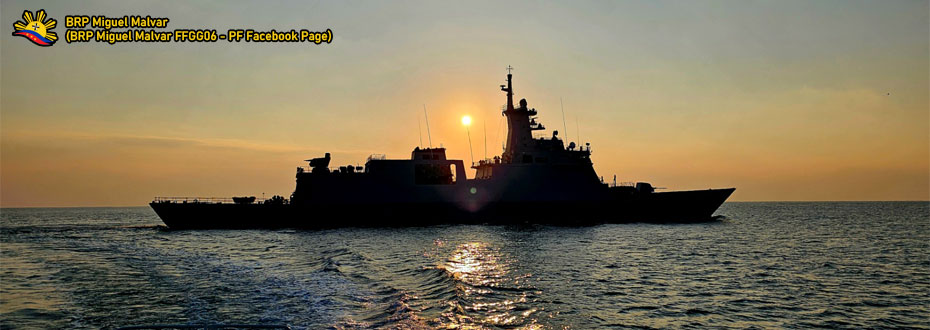

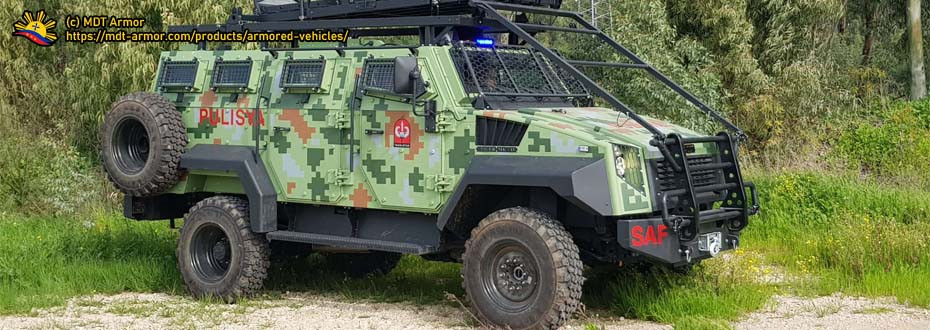

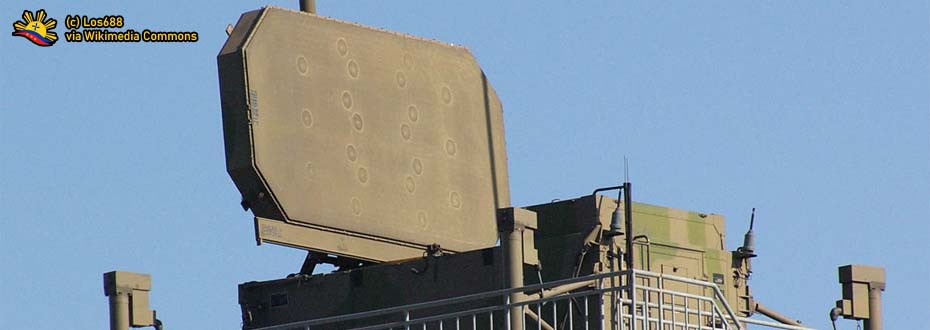







%20-%20PDA.jpg)


